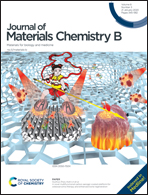A nanometer-sized protease inhibitor for precise cancer diagnosis and treatment†
Abstract
Inhibition of pro-cancer proteases is a potent anticancer strategy. However, protease inhibitors are mostly developed in the forms of small molecules or peptides, which normally suffer from insufficient metabolic stability. The fast clearance significantly impairs the antitumor effects of these inhibitors. In this study, we report a nanometer-sized inhibitor of a pro-cancer protease, suppressor of tumorigenicity 14 (st14), which has been reported as a potent prognostic marker for multiple cancers. This st14 inhibitor was fabricated by conjugating a recombinant st14 inhibitor (KD1) with carbon quantum dots (CQDs). CQD-KD1 not only demonstrated high potency of inhibiting st14 activity in biochemical experiments, but also remarkably suppressed the invasion of breast cancer cells. In contrast to the original recombinant KD1, CQD-KD1 demonstrated a prolonged retention time in plasma and at the tumor site because of the reduced renal clearance. Consistently, CQD-KD1 demonstrated enhanced efficacies of suppressing tumor growth and cancer metastases in vivo. In addition, CQD-KD1 precisely imaged tumor tissues in cancer-grafted mice by specifically targeting the over-expressed st14 on the tumor cell surface, which indicates CQD-KD1 as a potent probe for the fluorescence guided surgery of tumor resection. In conclusion, this study demonstrates that CQD-KD1 is a highly potent diagnostic and therapeutic agent for cancer treatments.



 Please wait while we load your content...
Please wait while we load your content...